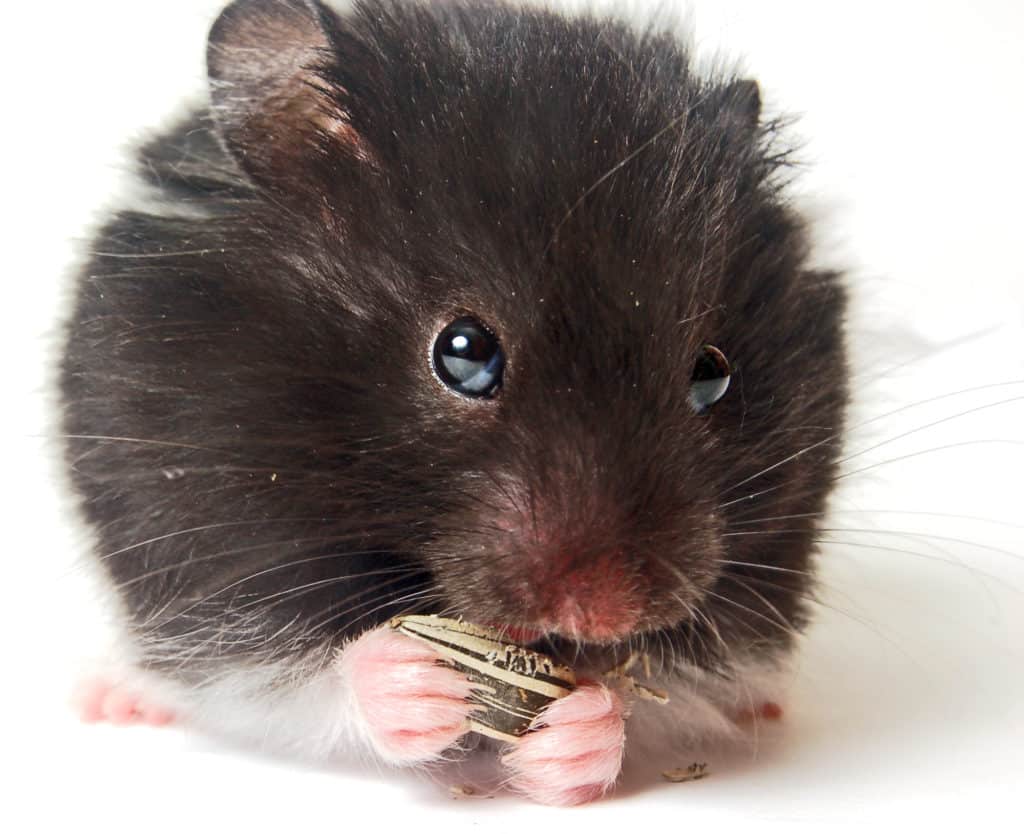Hamsters are incredibly active creatures. Unlike human beings, they spend most of their time running and playing. But despite being so energetic and active, pet hamsters are still prone to diseases that can significantly impact their lifestyle. A hamster eye infection is one such illness that needs immediate care. As a pet owner, it is your responsibility to look at the symptoms, figure out if your hamster is infected, and take the appropriate measures.
But don’t worry. It is not as scary as it sounds because you are not alone. This blog post will help you find out how to determine if your hamster’s eye(s) is infected, why it is infected, and what to do about it.
Hamster eye infection & other hamster eye problems
1. Hamster eye infection
A hamster’s eye can get infected due to several reasons. Let’s look at the most probable causes of such an infection.
Causes
- Injury – A hamster is a pet that runs a lot. The Roborovski hamster, the most active hamster species, runs almost 6 miles in a single night. That is the same as a human running four marathons. So, obviously, during all that running, a hamster could bump onto something and injure himself. Through this injury, harmful pathogens can enter his eye and cause an infection (For example, bacterial infections).
- A foreign object – Sometimes, when you walk on a dusty road, dust or sand can end up in your eyes. Then, as you rub your eyes due to the itching, your eyes become red. The same can happen to your hamster. A foreign object, like a small piece of your hamster’s bedding or food item, can enter his eyes and cause an infection.
- Allergy – At times, a hamster can become allergic to his bedding, toys, etc. This can also be the reason behind a hamster eye infection. Some food items can also cause allergies.
- Ulcer – Corneal ulcers can occur due to injury from the cage or other hamsters. It can also be caused when your hamster constantly scratches his eye due to the irritation caused by the presence of a foreign object or an allergy.
- Poor sanitation – If the room where the hamster’s cage is, has a lot of moisture, then bacteria and fungus (mold) can grow in the bedding and toys, especially those made of wood. The same can happen if you have a hamster bowl in the cage that your hamster accidentally tips off, and you don’t replace the wet bedding promptly.
Symptoms
Now that you know what causes an eye infection in hamsters let’s find out the symptoms that indicate an infection.
- Swelling of the eye and/or the area around it
- Red eyes
- Watery eyes
- Green or yellow pus oozing out
- Sticky eyes
- Cloudy eyes
- Hamster pawing at the face constantly
Typically, if there is an infection, the eye(s) will first become red in color. Then it will swell, followed by the oozing of pus. Finally, the hamster would become unable to open his eyes properly (Source: The Hamster Care).
Treatment
If you house several (dwarf) hamsters in a single cage, the first thing to do is to separate/quarantine the sick hamster. If not, the infection can spread from the sick hamster to the healthy hamsters.
The symptoms of hamster eye infection and several other eye problems are similar. So, the best thing to do is to take your hamster to a veterinarian if you notice any of the symptoms mentioned above.
The vet might first clean the infected eye with a solution. Then, he might prescribe an oral or topical medication for your hamster. In case of corneal ulcers, the vet might prescribe an ointment or eye drops. Sometimes, antibiotics might also be prescribed.
2. Protruding eyes (Eye Bulging)
Eye bulging, also known as Exophthalmia, is when a hamster’s eye(s) protrudes from its natural position.
The eye sockets of hamsters are shallow, and their orbital sinus is well-developed (Source: PetMD). (Orbit is the bone cavity in which the eyeball and its associated nerves, vessels, and muscles are present (Source: MSD Vet Manual). A sinus is a hollow cavity lined with soft pink tissue (Source: WebMD)).
It is normal for the eyes of hamsters to bulge a little. But Exophthalmia is often caused by an underlying condition.

Causes
Eye bulging can be caused by:
- An abscess (A collection of pus within a tissue) behind the eye
- Glaucoma (More on this later)
- Allergies
- Dental disease
- Cancer
- Injury to the eye
- Poor sanitation
- Improper handling (Pressing the hamster too hard while holding him)
Symptoms
If your hamster suffers from this medical condition, then he will portray one or more of the following symptoms:
- Your hamster’s eye(s) swells or is no longer in the socket.
- The eyes do not look symmetrical when seen from above.
- Your hamster repeatedly paws at his face.
- Eyes change color.
- Discharge (or tears) from the eyes.
- The hamster has trouble moving around in his cage and finding things because of his difficulty seeing. He might even bump onto things.
- He has trouble eating
- Loses weight.
Treatment
If you find any of the above symptoms, take your hamster to a veterinary doctor as soon as possible. He will be able to determine the reason behind the protruding eyes.
Your vet might prescribe antibiotics and medicine for your hamster’s eye(s). Since this condition is painful for hamsters, he might prescribe pain killers as well. If a dental abnormality is the reason behind the protruding eyes, your vet could take medical measures to correct the abnormality.
In some extreme cases, treatment might not be possible anymore. Hence, the eye must be removed surgically.
Prevention
Your hamster’s eyes can also protrude due to poor sanitation. So, keep your hamster’s surroundings clean.
Take your hamster to the vet regularly so that any health problems can be identified early and suitable measures can be taken promptly.
3. Pink eyes
Also known as Conjunctivitis, Pink eye is another common hamster eye infection. It can occur when the pink tissues (orbital sinus) around the eyes of the hamster get irritated and inflamed, often accompanied by a bacterial or viral infection (Source: The Spruce Pets). The causes and symptoms are similar to Exophthalmia (Bulging eyes).
Causes
- Poor sanitation
- Irritation due to bedding
- Bacterial infections
- Trauma/injury (from another hamster or cage)
- Dental problems
Symptoms
- Redness around the eyelids
- Sticky eyelids
- Excessive discharge from the eyes
- Crusting (the discharge dries) around the eyelids
- Swelling
Treatment
Both bacterial and viral conjunctivitis are highly contagious (Source: The National Library of Medicine). So, if you house several dwarf hamsters together and one of them shows signs of infection, you should promptly separate the infected hamster from the healthy hamsters and quarantine him. After that, take him to a vet as soon as possible. The vet will most likely prescribe eye drops and antibiotics for your hamster. If the vet determines the reason for the Pink eye to be an allergy to the bedding, you must change the bedding immediately (Source: Academy Pet Hospital).
Prevention
The only external factor that can cause Pink eye is poor sanitation. So, clean and sanitize your hamster’s cage regularly to prevent Pink eye.
4. Sticky eye
The Sticky eye is a medical condition where the hamster will be unable to open his eyes as his eyes will be glued shut. Even though younger hamsters could also suffer from Sticky eyes, older hamsters are more likely to get it.
Causes
The main cause of Sticky eyes is eye weeping. Eye weeping is the condition where secretions come out of your hamster’s eyes when he sleeps. By the time he wakes up, these secretions could dry up and glue his eyelids together. So, your hamster might be unable to open one or both his eyes after waking up. Eye weeping can be caused by one of the two reasons below:
- The eyes secrete a fluid to help them stay moist and prevent them from drying out. These fluids are produced even during sleep. However, as a hamster gets older, he tends to sleep longer. So, excess fluids can build up inside the closed eyelids and dry out, making them stick to the eyes.
- Tear ducts play an important role in keeping the eyes clean and lubricated. They keep the eyes free from foreign particles as well. Tear ducts also transport fluids and tears from the eyes into the nose. If the tear ducts are blocked, the drainage system of the eyes won’t function properly anymore as the excess fluids from the eyes cannot be drained into the nose. As a result, eyes become watery, increasing the chance of Sticky eyes and causing infection and inflammation. Aging increases the risk of tear duct blockage in hamsters (Source: Hammys world).
Symptoms
- Unable to open the eyes after waking up
- Crusting (dried discharge) around the eyes
- A thick yellowish discharge oozing from the eyes normally indicates a blocked tear duct
A hamster’s eyes being closed could also be due to other medical conditions like Pink eye. So, besides your hamster being unable to open his eyes, if his eyes are also red, swollen, protruding, or if there is no crust around his eyes, or if he is in pain, then it is most probably not Sticky eye. In these cases, take your hamster to a vet. But if you don’t observe these other symptoms and you are sure that it is Sticky eyes he is suffering from, you can follow the measures below to treat it at home.
Treatment
Sticky eye is one of those medical conditions that can be treated at home. To treat Sticky eyes, perform the following steps.
- Prepare a saline solution (made by dissolving salt in water). Since salt water is a natural antiseptic, it can kill the harmful pathogens in your hamster’s eyes as well. So, it is doubly effective against an eye infection like Sticky eye (Source: Main Street Optometry). But the salt should be non-iodized.
- Take a cotton bud and dip it lightly in the saline solution.
- Take your hamster out of his cage and hold him gently in your lap. But make sure he can’t jump and fall down.
- Keep the moist bud on the crust around your hamster’s eye for about two minutes. It will dissolve the dried discharge and loosen the crust.
- Take a new cotton bud. Dip it in the saline solution again and keep it on the undissolved part of the crust for two minutes until it dissolves.
- Repeat the above process until the crust around your hamster’s eye completely dissolves.
- By this time, your hamster should be able to open his eye. However, if he is still unable to open his eyes, then take a soft cloth and wipe away the dissolved discharge.
- If the other eye of your hamster is also stuck close, repeat the same process for this eye as well.
- If even after performing the above process, your hamster is not able to open his eyes, you should take him to a vet.
- But even if your hamster opens his eyes after performing the above procedure, you shouldn’t stop here. You should repeat this process for a week with a new saline solution every day. Monitor him during the day as well so that you can clean up any discharge as soon as it comes.
- If you have several dwarf hamsters, and one of them suffers from Sticky eyes, you should quarantine the infected hamster from the other hamsters until there has been no discharge or crust formation for at least 48 hours (Source: Erin’s animals).
- If you think that Sticky eyes might have been caused by the blockage of tear ducts, take your hamster to a vet right away.
5. Glaucoma
Glaucoma is a medical condition where the optic nerve that connects the eye to the brain gets damaged (Source: National Health Service, UK).
Cause
Have you ever wondered what is inside the eyeballs and why they have such a shape?
The eyeballs are filled with a fluid, which constantly circulates in and out of the eyes (Source: Share care). Without it, the eyeballs would collapse. Normally, the amount of fluid produced in the eye is equalized by the amount of fluid flowing out of the eye (through microscopic channels) into the bloodstream. This balance creates the pressure needed to maintain the eyeballs in a constant shape.
But what would happen if this balance was broken? What would happen if too much fluid is produced by the eye or if the produced fluid cannot escape from the eye?
As you guessed, the pressure inside the eyeball will rise, causing the eyeball to change shape. As a result of this, the optic nerve that connects the eye to the brain might also get damaged. This is called Glaucoma.
Nobody is 100% certain as to what causes Glaucoma in hamsters. Maybe, it is a hereditary disease passed down through the genes.
Dwarf hamsters are more prone to Glaucoma than Syrian hamsters (Source: Hammy’s world).
Symptoms
The biggest and most important symptom of Glaucoma is that the hamster’s eyes will protrude.
Treatment
As explained before, many other factors can cause a hamster’s eyes to protrude. So, if you find that your hamster’s eyes are protruding, then take him to a vet immediately. He will be able to determine the reason behind the protrusion.
The vet will prescribe medicines if needed. In severe cases, the hamster’s eye(s) may be removed.
6. Cataracts
A cataract is a disease that not only affects humans but also hamsters.
Cause
The most commonly known cause of cataracts is old age.
Symptoms
If you notice a cloudy film on your hamster’s pupils or if they are completely opaque, it is most likely a cataract.
Treatment
In humans, cataracts can be removed surgically. But a hamster is too small for that. So, unfortunately, there isn’t any cure for cataracts in hamsters. Cataracts can lead to partial or complete blindness. But fortunately, that isn’t a big handicap for hamsters because they have learned to rely on their other senses more as their eyesight is already bad, to begin with.
7. Entropion (Eyerub)
Entropion is a medical condition where the eyelid turns inward against the eyeball. This will cause the eyelid to rub against the eyeball, causing not only irritation but also excessive tearing, pain, and decreased vision.
Cause
It is a genetic disorder found mostly in Rex varieties (Breeds of Syrian and Campbell hamsters, whose fur and whiskers appear as if they have been folded).
Symptoms
- Twitching eyelids
- Watery eyes
- Hamster squinting and rubbing his eyes
- Hamster becoming aggressive due to pain
FAQ
Why is my hamster keeping one eye closed?
If your hamster keeps one eye closed and if you can notice the formation of crust around that eye, he could be suffering from the Sticky eye medical condition. You can treat it at home.
However, if you find no crust around the closed eye and if there are additional symptoms like the region around the eye is red, if the eyes are swollen, or if your hamster seems to be in pain, it is most probably not Sticky eye. In such a case, you should take your hamster to a vet.
How can I treat eye infection at home?
Not all eye problems can be treated at home. Only Sticky eyes can be treated at home (Please refer to the steps mentioned under the section ‘Treatment’ under the topic ‘Sticky eyes’).
What does it mean when a hamster has a swollen eye?
Swollen eyes can indicate an underlying medical condition like Protruding eyes, eye infection, Pink eyes, or Glaucoma. So, take your pet to a vet as soon as possible. Do not attempt to treat it at home.
Can an eye infection kill a hamster?
Eye infections in hamsters are generally not fatal. In the worst-case scenario, their eye(s) might be removed surgically. This will understandably make them blind. But since birth, a hamster learns to rely on his other senses as his eyesight is terrible. He can only see for a few centimeters past his nose. So, becoming blind won’t drastically impact his lifestyle. So, simply put, eye infections don’t kill a hamster.
If you are a hamster owner who cares for his pet, you will definitely be worried if your hamster suddenly becomes sick or acts clumsy. But to make sure that your hamster is safe and can live long, you should always be on the lookout for symptoms indicating any sicknesses. And to do that, you should make yourself knowledgeable about the various illnesses/diseases that can affect your hamster, their symptoms, and how to treat them. To that end, I hope this blog post has helped you.
This blog post is only meant to be used as a source of knowledge. In no way can it match a veterinary doctor’s education and experience. So, if you think your hamster shows symptoms of any of the diseases mentioned above, consult a vet immediately.



